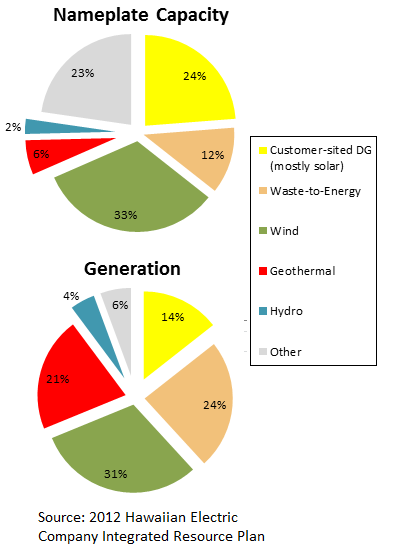Hawaiian Electric Company’s Integrated Resource Plan – Welcome to Fantasy Island!
by Davis Swan, Black Swan Blog, August, 2013 (excerpt)
On June 28, 2013 the Hawaiian Electric Company (HECO) released its Integrated Resource Plan (IRP) which outlines how it will meet electricity demand over the next five years and how it will achieve the Renewable Portfolio Standards (RPS) which require that 25% of generation be from renewables by 2020 and 40% by 2030....
What I find conspicuously absent from the HECO IRP is something called common sense....
...The challenge facing Hawaii can be visualized through two charts which focus on renewable generation in 2012;

One notable aspect of these charts is the large discrepancy between the Nameplate capacity and actual generation. The Geothermal facility on the Big Island represents only 6% of nameplate capacity and yet it generated 21% of the total renewable electricity during the year. The reason? Geothermal is reliable. In fact the Puna facility had a utilization rate of 80%. The same situation applies to the large waste-to-energy plant on Oahu which incinerates most of the solid waste generated on Hawaii’s most populous Island and outputs up to 90 MW of electricity.
Wind energy generation is roughly equal to its proportion of nameplate capacity. That sounds promising until you consider that about 50% of that production takes place at night in periods of low demand. There are also frequent periods of relative calm so that relying upon wind is simply not feasible.
The area of most concern is with PV solar which happens to be the fastest growing source of renewable generation in the state. Up until now the many financial incentives implemented to encourage the installation of roof-top solar panels have been very effective. But the IRP acknowledges that when the amount of PV Solar at mid-day reaches a critical point there are problems;
“When the aggregate PV capacity is greater than 100% of minimum load, this could result in power flow from the generating facilities back toward the substation, negatively impacting equipment loading, voltage, system operational impacts, and protection of the Company’s system.”
The widespread adoption of roof-top solar is also resulting in significant economic inequities amongst HECO customers. This is something I discussed in a recent blog posting. The IRP describes the situation as follows;
“As the amount of installed rooftop PV grows within Hawaii, it is creating significant economic cost transfers between groups of Hawaii’s citizens. These include the fact that Hawaii taxpayers are providing tax credit subsidies for new PV that do not accrue to non-PV owners; the feeder upgrade and operational requirements that increasing levels of PV impose upon utility customers; and as more PV owners (often more affluent citizens) generate their own energy, they leave fewer customers remaining on the utility system to pay for the fixed capital and operational non-energy costs of system operations.”
So from both physical infrastructure and economic fairness perspectives a continuation of the current pace of PV installations does not appear to be sustainable....
read ... Welcome to Fantasy Island!